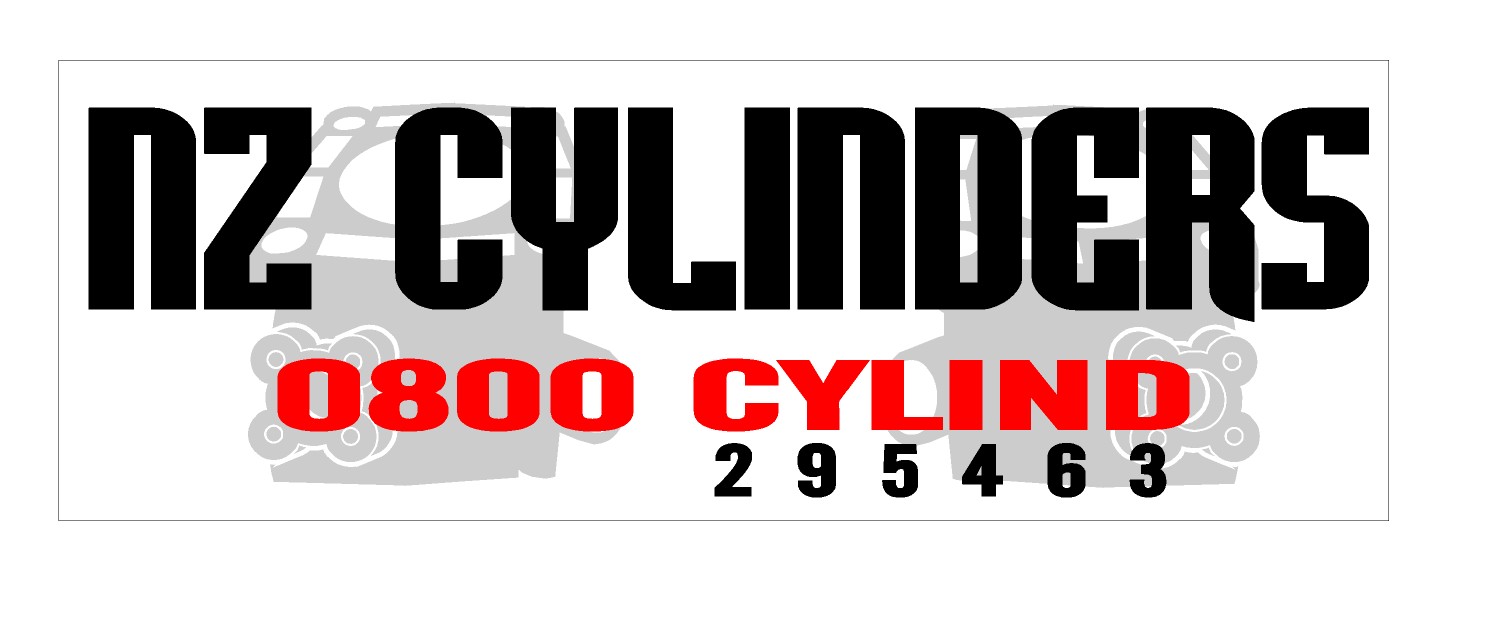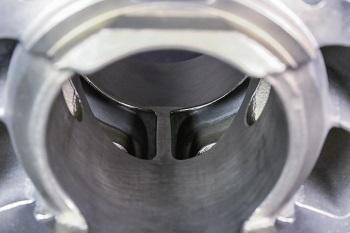

| Aprilia, Ducati,Honda, Husqvarna, Kawasaki,KTM, Maxter,Suzuki, Yamaha, Porche, Polaris, SeaDoo, TM |
|---|
| What to send with your cylinder |
|---|
For reliability the exhaust port width should not exceed 72% of bore diameter, however there is power to be gained from increasing the exhaust port width. There are 2 ways of doing this.
1:- Add a bridge in the centre of the exhaust port to support the piston and piston ring
2:- Use a smaller auxillary exhaust port either side of the main exhaust port. These are often placed above the "A" transfer ports.
The auxillary ports are much more reliable than the bridged port. In this discussion I will focus on the troublesome bridged port.
First, please read this quote
"OK, this is an old-school 2-stroke engine builder trick Utah,...but that one that works VERY Well! The idea is that the exhaust port bridge in the 2-stroke is a necessary evil. It is the one fault of the efficiency of a tuned 2-stroke engine. Its necessary because it acts as a land for the rings to run against as the slipper piston passes the exhaust port on its stroke to keep the ring compressed. It’s the evil because it’s the absolute hottest part of the motor and the absolute MOST suseptable to cylinder failure or nikasil plating damage for 3 reasons…
1. It is the thinnest section in the combustion chamber and can not dissipate heat. (Imagine taking a torch and heating the entire surface of a sewing needle. If you heat the needle’s eye, the shaft, and the point evenly, which part glows red first? The needle point does because it is the thinnest surface area that can not dissipate the heat).
2. All of the expanding burning hot gasses must pass by it. (Physics of Convection Dynamics)... (Imagine taking that same blow torch and blowing the flame evenly thru the center of your cylinder. It heats up in 360 degree radiation of the heat source. Now focus the flame onto one part of the cylinder. In addition to the heat from thermal radiance, the surface contact point heats up dramatically hotter because of the convection (movement) of the hot expanding gas molecules are bombarding and moving around it. Same thermal convection effect as the hot expanding combustion chamber gasses bombarding and having to move around the exhaust bridge.)
3. In lieu of both of the above critical faults, the exhaust bridge is NOT encompassed by the water jacket to get cooled
Most cylinder failures in a properly jetted and sealed 2-stroke with good fuel and lubrication are on the exhaust bridge because it gets so damned friekin hot. This is especially true of plated cylinders where you first start to see the plating flake off around the exhaust bridge. Drilling the the piston is MASSIVE insurance against this failure from the bridge warping, cracking, or flaking its plated coating. This was done by numerous factory teams and engine builders in the good'ole days before MX had cams, valves, and timing chains. This was when the manufacturers wanted to sale thumpers and pressured the AMA to establish the rules that a thumper was allowed twice the displacement to be "Fair" against the oil burners.
This is how its done...When I set up a 2-stroke, I use set-up dye. An easily removable (wipe-off) acrylic-like paint that you can spray on a part to visually inspect the wear and contact areas during motor building. I spray the dye on the front of the piston (exhaust side) and allow it to dry. I then install the piston on the wrist pin (without the rings) and lightly seat the cylinder down on it.
Once I have the cylinder lined up and seated, I look thru the exhaust port (open exhaust port with no pipe), I cycle the crank (via kick starter) until the bottom ring land passes approx ½ inch above the top of the exhaust port into the compression/combustion chamber. Using an etching tool I lightly trace both the outer left and right sides of the exhaust bridge into the set-up dye on the piston, and then disassemble.
Now with the piston removed I can see where the exhaust port bridge is in the etchings of the dye and I find the center vertical axis between these two etchings. This is the center of the exhaust port bridge. Starting ¾ of an inch below the ring land, I drill two .050 holes vertically (one on top of the other) about ½ inch apart down the center axis between the two vertical left and right marks.
The idea concept is to allow the positive pressure in the crank case (on the pistons downward stroke) to mist just a fine little amount of the cool, raw fuel/air mix onto the exhaust bridge thru the piston holes each time the piston passes the bridge. The cool, raw fuel mix acts as a cooling agent and will surprise you by how much this little trick will drop the temp of the thin little exhaust port. At 6000 RPM’s the critical heat temp on that thin little exhaust bridge is getting misted and cooled with fuel and intake air 100x a second!
Some will say this looses horsepower, I don’t believe so as long as you line the holes correctly and mist the center axis of the bridge and not vent your positive crankcase pressure out of the open exhaust port. Even if does, the loss is very, very, very minimal…but IT WILL SAVE YOUR $500 plated cylinder.
As frdbtr pointed out… This is a commonality of Wiseco recomendation in SOME of their piston kits that most people don’t read. (Some applications do not use a single port exhaust bridge). I am not familiar with the other Wossner brand he named, but wiseco recommends it because IT DOES WORK and their pistons are FORGED instead of cast and do not lose integrity by drilling the holes in the piston wall.
A Note about OEM and cast pistons… The same cooling effect would be benefited from an OEM or any other piston. It’s not often recommended for cast pistons because the “sand-cast” piston will weaken at the metallurgical level when you drill holes in it unless you stress relieve and re-harden it.
Please, please, consider all of the above My Opinion Only,... but as an educated opinion I have been building cast-iron and nikasil 2-stroke motors for 25 years and I have yet to have a cylinder failure of the exhaust bridge since I learned this from World Champion Melvin Cooper (Cooper Company Machine and Racing) building 2-stroke Hydroplane racing engines back in my twenties." End of quote
I think whoever originally wrote that quote has covered most points, now let's get done to some speciffics.
 In this photo you can see the bridge has bee releaved, also the pockets above the exhaust port that house the power valves when they are fully open.
In this photo you can see the bridge has bee releaved, also the pockets above the exhaust port that house the power valves when they are fully open.
In the following sketch I am trying to illustrate the extreme distance from the super heated centre of the exhaust bridge to the nearest coolant passage.
Exhaust gas at full load can reach 650ºC (1200ºF), this is above the melting point of aluminium. The bridge expands but it is held captive by yhe much stronger and much colder, around 55ºC, cylinder so what happens is the bridge distorts, it bends into the cylinder, that is why we releave the bridge, and also gets thicker in cross section. Some of this distortion is permanent, as a result the bridge is shorter which can result in a tension crack forming. Usually this happens where the bridge is hottest.
Do all bridges crack? Not all of them, the worst culprits are Honda CR250, RS250 and others where the power valve withdraws into a recess above the exhaust port.
What can be done to reduce this? Keep the exhaust temperature down. That means keeping on top of tuning and engine maintenance and not thrashing the engine.
What have manufaturers done to reduce the problem?
Suzuki RGV250/Aprillia RS250 use a wider bridge (greater volume to surface area) for beter heat transfer plus they inject oil below the bridge.
Suzuki RG150, these use a cast in place cast iron liner with a wide bridge, oil injection below the bridge and, I've been told" a coolant passage throught the bridge.
Rotax, these do not have a central bridge, instead they are a 3 port style. One of the aftermarket suppliers of Rotax 125 kart cylinders has machined oil pockets (about the size of a split pea) below the main exhaust and auxillary exhaust ports. This seems to be effective.
As mentioned in the quote further up this page, drilling holes in the piston helps.
Can my cracked exhuast bridge be repaired? Yes we can weld most of it, usually about 50%, this in most cases is effective.
Can we guarantee that it will not crack again? No, if we were able to do that it would not have cracked in the first place.
Should I fit a new cylinder? Yes, if one is available but there is no guarantee it will not crack.
Will fitting a sleeve cure the problem? No. Simply the cast iron (steel liners are a misinterpretation of cast iron) are about 1.5mm thick, cast iron does not dissipitate heat as fast as aluminium so the sleeve that is exposed to hot exhaust gases will get a bit flustered. We have seem them crack too.
Do all Honda CR250 cylinders with bridges crack? No, the last model (electronic power valve?) has a removeable cylinder front and different cooling. These seem to be good but are not as common as the earlier cylinders so we cannot confirm whether Honda fixed the problem.
My cylinder does not have a bridge, it is the 3 port design, but has cracks from the main port to the auxillary ports. Can it be repaired? Yes, in most cases these seem to remain in one piece after welding